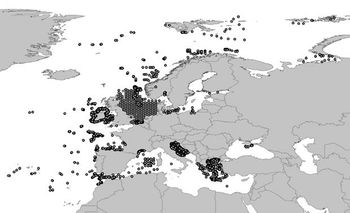MacroBen
Contents
Purpose
Often marine biological data are the result of projects with a limited temporal and spatial cover. By combining the small datasets obtained by such individual projects, massive databases can be created that make large scale analyses possible. Such datasets are especially important when one considers the recent observation of major shifts of marine species due to global change. The MarBEF working group Global Patterns of Marine Biodiversity across Ecosystems (Theme 1) created and integrated database (MacroBen) on soft-bottom macrobenthos. [1]
Creating the MacroBen database
Each dataset was archived and described in detail at the data centre of the Flanders Marine Institute (VLIZ). Describing these datasets in a standardised way made it possible to create a searchable metadata inventory. This metadata - data about the data- helps scientists to discover desired data and also enables them to share their data with other scientists. Archiving the datasets prevents them from being lost by ensuring the long-term integrity of the data. 28 of the child databases can be found here, the other 18 here.
The MacroBen database integrates datasets on soft bottom macrobenthic fauna from all European seas. A total of 46 datasets, from 24 European institutes, were collected, harmonised and integrated into a relational Access database. The integrated database includes data on organisms and several abiotic parameters ranging from the northeast Atlantic and the North Sea, Norwegian Sea and Arctic Ocean, the Baltic Sea and the Mediterranean and Black seas. During harmonisation of the different datasets problems occurred because not all datasets used the same taxonomy and sampling methods or didn't mention which datum they used to indicate the sampling position[1].
The MacroBen database
The MacroBen database contains data obtained between 1937 to 2005 by different research and monitoring programmes. It contains 7203 valid macrobenthos taxa names (ranging from phylum to subspecies level) and 40.766 abiotic readings from 75 different water or sediment parameters. The database includes 22.897 different sampling stations and 465.354 different distribution records. Most of the samples came from the North Sea and the North-east Atlantic region. Datasets from the Belgian part of the North Sea and the southern part of Dutch continental shelf account for 37% of the total biotic records, while less than 0.05% of the all MacroBen records in are from the Skagerrak and Baltic Sea region.[1]
Data policy
All data stored in the MacroBen database are subject to the Declaration of Mutual Understanding for Data Sharing within MarBEF Theme 1. The policy implies that the participating institutes, organisations and/or the collector of the dataset remain owners of their contributed dataset, and in control of the conditions under which datasets can be used by a third party.
It was agreed to make at least presence/absence data available as soon as a first round of papers based on the combined database was published. Data would be published through EurOBIS, one of the activities of the MarBEF network. From there, the data would be available for inclusion in the International Portal of OBIS and the Global Biodiversity Information Facility GBIF.[1]
Papers
The following papers have been published using the MacroBen database
See also
Somerfield, P.J., Arvanitidis, C. and Vanden Berghe, E. (eds.) 2009. Large-scale studies of the European benthos:the MacroBen database. Mar. Ecol. Prog. Ser. 382: 221– 311
References
- ↑ 1.0 1.1 1.2 1.3 Vanden Berghe, E.; Claus, S.; Appeltans, W.; Faulwetter, S.; Arvanitidis, C.; Somerfield, P.J.; Aleffi, I.F.; Amouroux, J.M.; Anisimova, N.; Bachelet, G.; Cochrane, S.J.; Costello, M.J.; Craeymeersch, J.A.; Dahle, S.; Degraer, S.; Denisenko, S.; Dounas, C.; Duineveld, G.; Emblow, C.; Escaravage, V.; Fabri, M.-C.; Fleischer, D.; Grémare, A.; Herrmann, M.; Hummel, H.; Karakassis, I.; Kedra, M.; Kendall, M.A.; Kingston, P.; Kotwicki, L.; Labrune, C.; Laudien, J.; Nevrova, E.L.; Occhipinti-Ambrogi, (2009). MacroBen integrated database on benthic invertebrates of European continental shelves: a tool for large-scale analysis across Europe. Mar. Ecol. Prog. Ser. 382: 225-238
